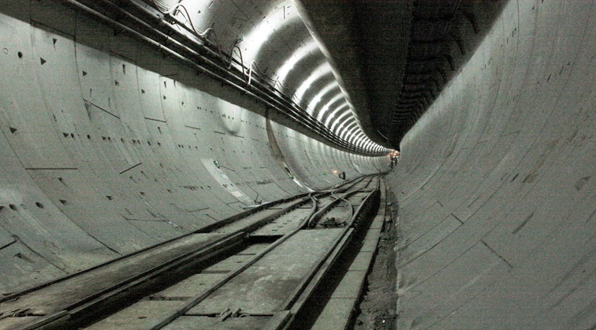Innovation projects
We incorporate the most modern technology to improve the public transport services, make them easier to use and to protect the environment.
See our innovation news archive (CA)
Discover some of the projects we are innovating:
100% electric autonomous bus
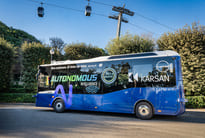
Barcelona welcomes a new player in sustainable and innovative mobility: the autonomous bus. This vehicle is 100% electric, measures 8 meters in length, and stands out for its ability to operate without human intervention thanks to its Level 4 automated driving technology.
The bus, manufactured by the Turkish company Karsan, is a model called Autonomous e-ATAK. It has a capacity of up to 52 passengers and is equipped with the FLOWRIDE.IA automation system developed by ADASTEC. The vehicle offers a range of up to 300 kilometers on a single charge thanks to its high-efficiency lithium batteries. Its design allows it to detect all objects around it, interpret traffic signals, and navigate the urban environment along a predefined route.
The pilot test of this autonomous vehicle was carried out in Montjuïc, where the bus operated for ten days. Although local regulations require the presence of a driver on board, the vehicle is fully capable of driving autonomously. In addition, its system includes remote and satellite monitoring to continuously track the route and the vehicle’s operations.
For more information, visit TMB News.
Smart bus stops
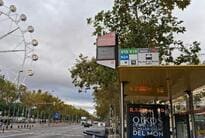
At the end of 2025, TMB installed smart bus stops across its network, a project launched by the Barcelona Innova Lab Mobility. This technology makes it possible to collect real-time data to improve service quality and the user experience. In addition, it provides information on passenger behavior, unauthorized occupations in bus lanes, and other variables that affect the operation of the network.
Smart bus stops represent a step forward in the innovation and digitalization of public transport in Barcelona. With more than 100 lines and 750,000 daily validations, the bus network is one of the fundamental pillars of metropolitan mobility.
The first trial of this technology was carried out at about fifteen bus stops throughout the city. The project was presented at the international Tomorrow Mobility World Congress and will last for twelve months, during which data will be collected and analyzed to study new applications and improve the technology applied to the network.
For more information, visit TMB News.
Support for accessibility on our transport networks
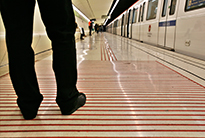
Como parte del compromiso con la accesibilidad universal, TMB ha desarrollado herramientas tecnológicas de apoyo para personas con discapacidad: por ejemplo, el programa Sigthos, que facilita el acceso de los discapacitados auditivos a los centros de atención al ciudadano; el avisador portátil Avicus, que previene a los invidentes de la existencia de obras en el metro, o los bucles de inducción magnética, disponibles en las audioguías del Barcelona Bus Turístic, para personas con audiófono o implante coclear.
Otro proyecto destinado a mejorar la autonomía de los usuarios con discapacidad visual es la implantación de las etiquetas inteligentes NaviLens en el metro y el bus. El objetivo de esta tecnología es guiar de una manera precisa sus desplazamientos por la red de transporte público, mediante la lectura en una aplicación móvil de estas etiquetas, que contienen un nuevo tipo de códigos QR, denominados ddTags.
A través de las Opciones de guiado en la parada de bus de TMB App, cuando una persona con discapacidad visual quiere acceder a un autobús, puede elegir la línea y el destino a través de su dispositivo móvil, que detecta el primer autobús que esté llegando a la parada donde esté.
Más información, en la sección Accesibilidad y movilidad reducida.
H16 and V15, the two first completely zero-emission lines
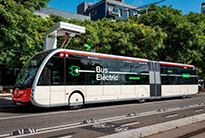
La línea H16 fue la primera que se reconvertida íntegramente a la emissión cero en la ciudad, en 2021. A principies de 2023 se reconvirtió también la línea V15.
Los vehículos, además de estar preparados para la carga rápida en ruta, incorporan destacados adelantos tecnológicos y marcan el camino de un salto hacia adelante en la calidad ambiental y en el nivel de seguridad del transporte público urbano.
L autobuses, están equipados con un pantógrafo plegable sobre el techo que se acopla a los puntos de recarga rápida situados en los extremos de la línea. A través del pantógrafo, los vehículos pueden cargar, en el tiempo de regulación, la energia suficiente para recorrer el trayecto hasta la terminal del extremo contrario. La carga rápida en ruta se combina con la carga lenta durante las noches en cochera, donde también se ha instalado el equipamiento correspondiente. Así, se asegura que estos autobuses sean autónomos y plenamente operativos a lo largo de una jornada sin tener que dotarlos de baterías voluminosas y pesadas.
Además del soble sistema de carga, los autobuses incorporan destacadas novedades tecnológicas orientadas a la mejora de la seguridad y sostenibilidad:
- Sustitución de los espejos retrovisores por un sistema de cámaras inteligentes que ayudan al conductor en la visión exterior; el Solaris añade sensores ultrasónicos de proximidad en la parte posterior.
- Sistema de visión perimetral de 270° para facilitar las maniobras a baja velocidad.
- Ruedas de aluminio, de menor peso, para reducir el consumo y mejorar la durabilidad.
- En el Irizar, pasillo de acordeón translúcido que aporta luminosidad a una parte habitualmente opaca del interior.
- En el Solaris, luces automáticas y limpiaparabrisas inteligentes.
- Adicionalmente, los vehículos estarán equipados con el sistema Mobileye.
Como todos los autobuses articulados, cuentan con las características de confort y accesibilidad siguientes:
- Cuatro puertas, para la entrada simultánea por las dos delanteras.
- Facilidades para personas con movilidad reducida: plazas reservadas, rampa retráctil, pulsadores para invidentes, piso bajo antideslizante.
- Pulsadores de apertura inteligente de puertas.
- Conectores USB para la carga de dispositivos móviles, WiFi ciudadano.
- Aire acondicionado.
En términos de confort, la tracción eléctrica supone, además, que la marcha es silenciosa y progresiva.
Zero emission electric buses
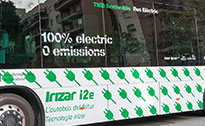
Barcelona es una de las diez ciudades europeas que realizó pruebas con autobuses eléctricos en el marco del Proyecto ZeEUS (Zero Emission Urban Bus System), financiado por la Unión Europea y coordinado por la Asociación Internacional de Transporte Público (UITP). El objetivo de las pruebas era desarrollar vehículos 100% eléctricos de alta capacidad. Además de Barcelona, también participaron ciudades como Londres, Glasgow, Estocolmo, Münster, Bonn, Pilsen o Cagliari.
La participación de Barcelona en este proyecto de investigación y desarrollo consistió en introducir, en el servicio regular de TMB, cuatro autobuses eléctricos de emisión cero con dos tecnologías diferentes. En concreto, dos autobuses estándar del modelo i2e de Irizar, equipados con baterías de carga nocturna, y dos Solaris Urbino 18e articulados, equipados con baterías que se cargan en la terminal durante el día.
La primera fase de pruebas se llevó a cabo en 2014 con los autobuses i2e de Irizar. En septiembre de 2016 se presentó la estación de carga y los primeros articulados eléctricos Solaris Urbino en pruebas, que empezaron a circular con pasaje en la línea H16 el 30 de enero de 2017. La V15 se electrificó por completo el 14 de marzo de 2023, por lo que a principios de ese año dos de las líneas de más de alta capacidad ya eran 100% eléctricas, con un total de 88 vehículos.
Estos vehículos articulados, propulsados por motores de 270 kW, dan servicio durante todo el día gracias al sistema de carga de las baterías, que se cargan mediante un pantógrafo situado en el techo del vehículo, en una estación de la Zona Franca ubicada a pocos metros de una de las terminales de la línea. En un intervalo de entre 5 y 8 minutos se carga hasta el 80% de la batería, y este tiempo es suficiente para que los autobuses puedan volver a realizar su recorrido.
Endesa colaboró en este proyecto instalando y gestionando los puntos de recarga, cuyo estudio permitirá diseñar la infraestructura necesaria para la electrificación de la flota de autobuses de Barcelona, que prevé llegar a 100 vehículos en el año 2024.
La participación de TMB en las pruebas del proyecto ZeEUS forma parte de las políticas medioambientales de TMB. Con la incorporación de vehículos eléctricos en la flota de autobuses, seguimos avanzando en la mejora del medio ambiente y en el objetivo de tener un transporte público completamente limpio.
El proyecto ZeEUS se cerró el 20 de marzo de 2018 después de haber dado un fuerte impulso a los autobuses 100% eléctricos. El acto de clausura se celebró en Bruselas, donde se expusieron los resultados de las diferentes soluciones de autobuses de emisión cero probadas en ciudades europeas, entre las cuales se encuentra Barcelona.
Para más información, puedes consultar los artículos sobre los autobuses eléctricos en la web de noticias de TMB y el dosier del Proyecto ZeEUS en Slideshare.
Project for the charging of electric vehicles
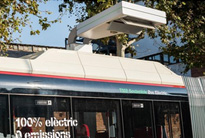
TMB es uno de los 39 socios de 12 países diferentes que participan en el proyecto ASSURED, que hace referencia a la electrificación de los vehículos de transporte urbano a través de soluciones avanzadas de carga rápida. El objetivo principal del proyecto es potenciar las flotas urbanas de emisión cero mediante este sistema.
ASSURED es un proyecto cofinanciado por la Unión Europea, coordinado por la Universidad Libre de Bruselas y liderado por la Unión Internacional de Transporte Público (UITP). Entre los participantes se encuentran autoridades y operadores de transporte, fabricantes de vehículos, proveedores de energía eléctrica y proveedores de infraestructuras de carga, así como distintas asociaciones, empresas de consultoría y municipios.
Con el objetivo de beneficiar la adopción de la tracción eléctrica de emisión cero por parte de las flotas de vehículos comerciales y de pasajeros, el proyecto se basa en los ejes siguientes:
- Desarrollo de soluciones modulares de carga de alta potencia de nueva generación (hasta 600 kW).
- Soluciones interoperables y escalables de carga de alta potencia.
- Desarrollo y prueba de soluciones eficientes de carga inalámbrica de hasta 100 kW.
- Evaluación del coste, la eficiencia energética y el impacto de la red eléctrica.
-
Prueba de las soluciones derivadas de ASSURED en 5 autobuses de transporte público, según la definición TRL 7 en ciudades de la Unión Europea.
- Apoyo a organismos de normalización (por ejemplo, CEN-CENELEC, ISO e IEC).
- Protocolo de pruebas estándar de conformidad e interoperabilidad.
Dentro del proyecto, la UITP lidera las actividades vinculadas con autobuses eléctricos y la coordinación con los usuarios finales. Barcelona participa en la segunda fase, junto con Osnabrück (Alemania), en la comprobación de la operabilidad entre autobuses y cargadores de marcas diferentes en operación real. Gotemburgo hará lo mismo con autobuses y camiones y Eindhoven ensayará la carga inteligente para una flota de gran volumen.
Automated metro
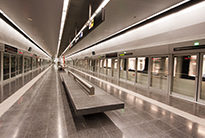
La automatización es la tendencia de futuro de las redes de metro, por seguridad, fiabilidad, flexibilidad y economía. Y Barcelona cuenta con la línea 9/10, la línea sin conductor de referencia en Europa, que incluye tecnología de control y supervisión de los trenes, arquitectura de las estaciones y la gestión innovadora de la operación. Además, también cuenta con la línea 11, una línea convencional que se ha automatizado.
Infórmate en la sección Metro automático.
Energy saving program on the metro
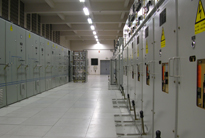
Desde julio de 2014, la estación de metro Passeig de Gràcia de la línea 3 se comporta como una pequeña ciudad inteligente. A lo largo del día se supervisan factores como la temperatura, la humedad, las condiciones climáticas del exterior y el volumen de pasajeros. En función de estos datos, se modulan los subsistemas de la estación como el alumbrado, las escaleras mecánicas y la ventilación. El funcionamiento de estos sistemas está pensado para que se reduzca el consumo sin que el usuario lo note.
Se trata de una acción del proyecto colaborativo europeo SEAM4US, cofinanciado por el 7.º Programa Marco (7PM) de la Unión Europea.
Si el experimento obtiene resultados positivos, está previsto estudiar la posibilidad de implantarlo en otras estaciones de la red de metro, siempre que represente una inversión mínima. Este proyecto se enmarca en las políticas medioambientales de TMB, que compatibilizamos con las necesidades de nuestro servicio.
Más información, en la web TMB Notícies.
Metro Control Center
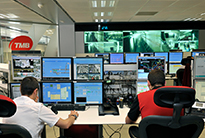
Es el cerebro y el corazón de la red de metro; es el lugar desde donde se vela día y noche por la regularidad y el buen funcionamiento de la red, tanto de las líneas convencionales como de las automáticas. Mediante sistemas de comunicación por radio y vídeo, y con la ayuda de los telemandos, se coordina la circulación de los trenes, los equipos de las estaciones, la energía y la ventilación, se resuelven las incidencias y se mantiene a los usuarios informados.
Para más información, consulta el documento El Centro de Control de Metro de Barcelona que encontrarás a continuación.
Channels and digital tools for travellers
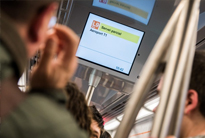
Aprovechamos los avances tecnológicos para ayudarte a ganar tiempo y planificar tus desplazamientos en bus y metro, tanto si estás en las redes de metro y bus cómo si estás en casa o en la calle:
- Cómo llegar: es una herramienta interactiva que te ayuda a desplazarte y planificar tus viajes en transporte público. Conoce cómo funciona Cómo llegar.
- iBus Próximo bus: esta herramienta de información en tiempo real usa la información del sistema de autobuses para calcular cuántos minutos faltan para que llegue el próximo autobús a tu parada. Información sobre el iBus Próximo bus.
- iMetro Próximo metro: ofrece información en tiempo real de los minutos y segundos que faltan para que los dos próximos metros en cada sentido de circulación lleguen a la estación seleccionada. Información sobre el iMetro Próximo metro.
- TMB App: es una aplicación para dispositivos móviles que te ayuda a moverte en transporte público. Ofrece muchas posibilidades de personalización a partir del perfil de usuario JoTMBé, y te permite comprar billetes online de una forma rápida y cómoda. Información sobre TMB App.
- Web TMB: ofrece cómo planificar recorridos a través de herramientas como Cómo llegar, muestra las alteraciones del servicio, informa sobre los diferentes billetes y tarifas y permite realizar trámites de atención al cliente a través de distintos formularios. El sitio contiene toda la información necesaria tanto para los usuarios habituales como para los visitantes de la ciudad, además de toda la información corporativa de la compañía. Se puede consultar desde cualquier dispositivo y, además, es accesible.
- Redes sociales: los usuarios de TMB pueden seguirnos a través de las distintas cuentas en las redes sociales, ya sea para informarse en tiempo real sobre el servicio, conocer mejor el transporte de la ciudad e informarse sobre novedades o para interactuar con nosotros.
Information screens in the bus network
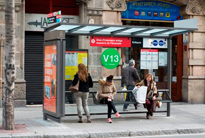
La red de bus operada por TMB dispone de diferentes sistemas de información que se ofrecen in situ y en tiempo real a los usuarios y contribuyen a mejorar la experiencia de viaje.
- Pantallas de información: las pantallas de las paradas, también denominadas pantallas de información al usuario (PIU), indican el tiempo de llegada de los diferentes autobuses de las líneas que efectúan parada allí y también de posibles alteraciones u otras informaciones.
- Sistemas de información a bordo del vehículo: una vez en el autobús, en función del tipo de vehículo, los usuarios pueden mantenerse informados gracias a las pantallas de información al usuario, que indican la próxima parada y los enlaces disponibles con otras líneas de autobús y de metro. Este sistema suministra la información visual y acústicamente.
- Postes solares: los postes solares disponen de un sistema energéticamente autónomo para ofrecer la información de paso del próximo bus mediante placas solares.
Information screens in the metro network
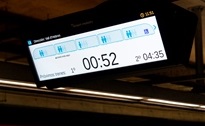
La red de metro operada por TMB dispone de diferentes dispositivos de información que contribuyen a mejorar la experiencia de viaje a los usuarios.
- Pantallas de información: la red de metro cuenta con sistemas de información al pasaje mediante paneles luminosos en los andenes, vestíbulos y accesos. Estas pantallas ofrecen el tiempo que falta para la llegada del próximo metro y también posibles alteraciones del servicio u otras informaciones.
- Sistemas de información: los usuarios pueden mantenerse informados a bordo gracias a las pantallas del sistema de información al usuario, que aportan información visual y auditiva con el nombre de la próxima parada y el recorrido de la línea con los enlaces disponibles a otros transportes públicos.
JoTMBé: your user account on TMB

Con JoTMBé los usuarios de metro y autobús de TMB pueden tener siempre a mano toda la información que necesitan para sus desplazamientos en transporte público. Se puede acceder al sistema desde cualquier dispositivo: navegado por la web de TMB desde el ordenador, desde el móvil o la tableta, o bien descargando la TMB App.
JoTMBé ofrece al usuario:
- Un espacio personal propio dentro de la web, pensado específicamente para gestionar las preferencias según los trayectos más habituales que se realicen.
- Comprobación directa de si existen incidencias en el servicio de las líneas que se utilizan frecuentemente.
- Creación de alertas de servicio por correo, que permiten mantenerse informado de las alteraciones previstas en las líneas, en las paradas de autobús y en las estaciones de metro que se hayan guardado como favoritos. La aplicación envía información con antelación sobre qué transporte alternativo puede usarse.
- Guardar lugares y trayectos más frecuentes y consultarlos en la web y la app con un solo clic. La aplicación también permite saber rápidamente cuáles son las rutas recomendadas en transporte público para desplazarse y localizar las paradas de autobús o metro más cercanas a la dirección que interese.
- Recibir información sobre afectaciones importantes a los servicios de bus y metro, posibilidad de ganar premios y recompensas con el Programa de Puntos JoTMBé y recibir un boletín electrónico periódico con información sobre TMB y el transporte público.
- Comprar billetes más rápida y cómodamente a través de TMB App.








